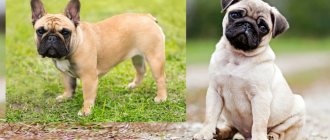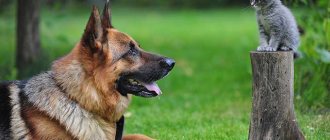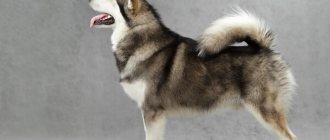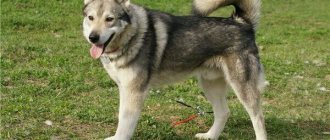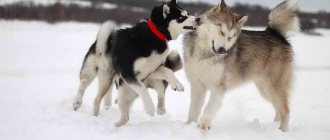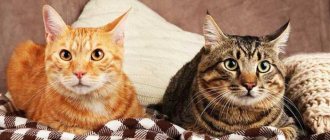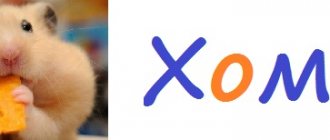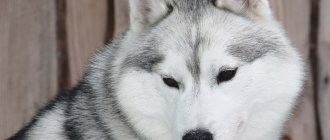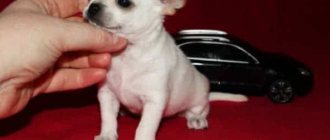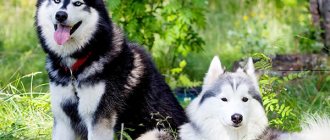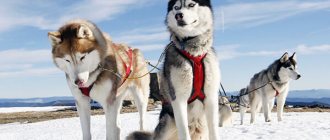Many people who are not very well versed in dog breeding confuse huskies and huskies and do not know what the difference is between them.
Indeed, there are many similarities between these two breeds, however, they have no less differences.
Moreover, this applies not only to the exterior, but also to the characteristics of the psyche, character, temperament and even purpose.
All this must be taken into account when keeping, raising and training these dogs, and therefore, anyone who is thinking about purchasing a husky or husky needs to study the similarities and differences of these two dogs before purchasing a puppy.
This will not only help provide the pet with the most suitable living conditions, but will also save their owners from disappointment in the future.
Brief information about Husky
Photo and description
The dog is of medium height (approximately from 50 to 60 cm at the withers, weight is about 15-28 kg), compact, but at the same time harmonious build.
The body is slightly stretched and exceeds the height at the withers by no more than 2-3 cm; the shape of the head from above resembles a triangle, slightly tapering towards the muzzle. The stop is well defined, but not sharp.
The length of the muzzle is approximately equal to the length of the cranial part of the head.
The ears are erect, triangular, of medium size, set quite close to each other.
The eyes are almond-shaped, slightly slanted. Their color can be blue, brown, amber, olive. In addition, different eye colors .
IMPORTANT!
The nose, as well as the pigmentation of the lips and rims of the eyelids, depending on the color, can be black or brownish.
The neck is of medium length, the chest is deep and powerful, but not too voluminous. The forelimbs are moderately wide, even and parallel. The hind legs are muscular, with well-defined angulations of the hock joints. The tail is similar to a fox's, in a calm state it is lowered downwards, but when alert, it is carried in the form of a sickle over the back.
The coat is not too long, two-layered, while the undercoat is thick and soft, and the coarser hair is quite smooth and adjacent to the body. The color can be almost any, although the most typical colors for huskies are grey-white, black-and-white, brown-white and reddish-white.
Advantages and disadvantages
Pros:
- Intelligence and intelligence.
- Ability to make decisions independently when necessary.
- Lack of aggression towards humans.
- Love for children and playful disposition.
- Loyalty to the owner.
- Endurance and unpretentiousness.
- Easy hair care.
- They make excellent sled or sport dogs.
Minuses:
- Not suitable as guard dogs.
- Tendency to dig up the earth.
- Sometimes they are headstrong and stubborn.
- They often howl.
- They can be aggressive towards smaller animals.
- They need a lot of physical activity and long walks.
- Out of boredom, they can start to damage things in the house.
Character
Lively and friendly towards people. Huskies, unless serious mistakes were made during their upbringing , are never aggressive towards humans and are not inclined to bite.
Friendliness towards strangers and lack of territorial instinct make these dogs poor guards and this must be taken into account by people thinking about purchasing such a pet.
Huskies have an innate hunting instinct, but they will not make hunters either. These dogs hunt for game only for their own food and will never give it up to their owner of their own free will.
These are independent, independent, and sometimes stubborn and willful animals, prone to running away and wandering.
In addition, huskies love to dig up the ground and, out of boredom, can chew furniture, tear off wallpaper, or howl like wolves.
However, when keeping these dogs in the house, you need to take into account that most of the bad habits of a husky are easy to remove or simply prevent them from appearing in your pet. This is achieved through early socialization and proper education and training.
In addition, as noted above, huskies act out mainly from boredom and idleness, and therefore, if you provide the dog with sufficient mental and physical stress, it simply will not have time for mischief.
Unrecognized
Breeds not recognized by the FCI include:
- Norwegian sports mestizos;
- Eskimo husky;
- wolf-dog;
- Sakhalin Husky;
- Chinook.
Norwegian sporting crossbreeds
Norwegian mixed breed Norwegian mixed breeds are the fruit of the painstaking work of the hands of breeders who carried out matings between:
- greyhounds;
- kurtshaars;
- pointers.
The dog was created specifically to participate in sports competitions and has good physical characteristics combined with a gentle disposition.
Buying such a puppy is not easy. Due to the lack of official confirmation, it is difficult to confirm the quality of the animal being purchased.
Eskimo Husky
Eskimo Husky
North American native dog of medium size. The animal is not suitable for families with small children and needs access to constant work.
The Laika is quiet, friendly, hardworking and has hunting skills. The fearless animal was used to hunt polar bears.
The pet is not suitable for keeping in warm climates and is susceptible to sunstroke.
Due to their rarity (there are no more than 5 hundred officially registered animals), the cost of puppies reaches 420 thousand rubles.
Wolfdog
Wolfdog
Wolfdogs are unique hybrids obtained by crossing wild wolves and German shepherds. The attractive appearance inherited from the wolf and the character inherited from the shepherd allowed the animal to be used in dog sledding and service work.
It will not be possible to purchase such a pet, since sales are prohibited. The breeding project and the results obtained belong to Russian scientists.
Sakhalin Husky
Sakhalin Husky
The result of crossing Akita Inu and Spitz from Japan. Animals are fearless, prone to dominance and strongly attached to their owners.
With prolonged loneliness, Sakhalin residents develop severe psychological problems leading to physical illnesses.
Prices for puppies start from 20 thousand and reach 50 thousand rubles.
Sakhalin Huskies are not suitable for apartment living and will throw a real concert after the owner leaves for work. At the same time, they perceive the harsh conditions of the Far North with ease, enjoying participation in human expeditions.
Chinook
Chinook
Due to the rarity of the breed, you will have to pay about 600 thousand rubles for a puppy.
The rarest breed bred by Americans. Despite its unprepossessing appearance (the dog can easily be confused with an ordinary mongrel), the animal develops impressive speed and competes with the popular husky.
With each passing decade, the number of officially registered representatives continues to decline.
In conclusion, I note that sled dogs are animals that require special conditions of maintenance. The good-natured disposition, devotion and lack of aggression that unite these pets will make them loyal and devoted friends, but the specificity of their working qualities determines the maintenance of constant activity.
Nordic dogs are not suitable for inactive people who spend time at work and live in a small apartment in the center of a metropolis.
A little about likes
Photo and description
Laikas are not representatives of one breed, but a breed group that unites several dogs similar in origin, appearance and purpose.
Most huskies are hunting dogs, although many are also suitable for other work. For example, the Nenets Laika is excellent at herding deer, and the Yakut Laika can be used not only for hunting, but also as a sled dog.
In terms of their physique and coat characteristics, huskies are very close to dogs of the so-called wild or wolf type. Moreover, representatives of different breeds of huskies differ from each other, first of all, in the structure of the head and muzzle.
All of them are characterized by a strong, but not squat, build, as well as pointed, erect ears and a tail curled into a full or incomplete ring.
The coat of these dogs is not too long, but at the same time very dense and thick, with an abundant, moderately soft undercoat.
Laikas can come in a variety of colors, but the most typical coat colors are wolf, gray or black, often accompanied by white markings of various shapes and sizes.
Advantages and disadvantages
Pros:
- Excellent hunting dogs, suitable for tracking a variety of game.
- Hardy and unpretentious.
- They are distinguished by good health and, often, long life expectancy.
- Balanced and calm character.
- Devotion and obedience.
- Goodwill towards people, which, however, does not prevent huskies from being good guards.
- Undemanding to nutrition.
Minuses:
- Not suitable for keeping in an apartment.
- Hunting huskies may be at risk of contracting a serious infection in the forest or field.
- Very strong shedding.
- Despite their devotion, they can become disobedient when chasing game.
Character
Laika is quite independent and proud; she recognizes only partnerships with her owner and does not tolerate either excessive familiarity or rudeness in handling herself. This is a very smart and quick-witted animal, which, depending on the current situation, can make its own decisions during the hunt.
Laikas are friendly towards people and make good companions for children, especially since most of these dogs have a cheerful and playful disposition. Laikas are distrustful of strangers, but without increased aggression.
NOTE!
These dogs have an innate viciousness and ruthlessness towards prey, therefore, huskies need early socialization, without which they can be dangerous to pets smaller than themselves.
Similarities
Despite their external differences and behavioral characteristics, dogs still have similarities. Let us highlight the main qualities that both breeds have in common:
- relationship of origin - both breeds are close to the wolf, cultivated in the North;
- active, temperamental, love fresh air, can withstand frost;
- accustomed to dog groups, they get along in a pack of their own kind;
- devoted to the owner;
- efficient, accustomed to following commands.
Both breeds will not snooze all day in a corner on a rug; they require long walks, running and air.
Main differences
The main characteristics by which huskies and huskies differ:
- Huskies have a denser and more muscular build, while huskies are taller and have lighter bones.
- Huskies' ears are rounded at the ends, while huskies' ears are pointed.
- Husky paws are wider, stronger and more powerful than those of huskies.
- Laikas have rounder eyes, while Huskies have almond-shaped eyes. In addition, the eye color of a husky can only be dark, and not blue or heterochromic, like that of a husky.
- The look of a husky expresses curiosity and energy, while the look of huskies shows balance, attentiveness and some wariness.
- The fur of huskies is coarser in texture than that of huskies.
- The husky's tail is held downwards or in the shape of a sickle, while in huskies it is curled into a complete or incomplete ring.
- Huskies are larger in size: their height reaches 60 cm and their weight is 28 kg, while huskies are smaller and weigh more than 23 kg.
Huskies are larger and heavier than huskies, they have stronger bones and better developed muscles. Laikas look taller and lighter-boned compared to them.
Husky ears are rounded at the ends, while husky ears are sharper, and eyes can be not only brown, but also blue and even different colors. Laikas can be exceptionally dark-eyed, and their gaze is calmer and more serious than that of a husky.
The main external difference between the husky and the husky is that the husky’s tail is wrapped in a ring, while the husky’s tail resembles a fox’s and hangs down when at rest.
Pomsky appearance
The exterior of a Pomsky is a variable value, highly dependent on the play of genes. For example, the first generation of puppies (F1) receives an equal number of external characteristics from their parents, which allows them to look half Husky and half Spitz. Usually, to produce offspring, they take a Pomeranian male and a Husky female, since a miniature Spitz “girl” will not be able to bear and produce relatively large mixed breeds. In most cases, insemination is carried out artificially, since sires that match each other in size are a rare phenomenon.
F1 Pomskies can interbreed with each other, but the end results of such “unions” will be slightly less impressive. In general, each subsequent mating (starting from F2) does not have the best effect on the appearance of the offspring. Not only will the mestizos of later generations differ in all respects from their older brothers and sisters, but this is also a direct path to degeneration. Perhaps this is why there are so few advertisements for the sale of F3 animals in Russian nurseries.
Pomsky face
The average Pomsky of the first generation is a 5-7 kg merry fellow with a height of about 30-40 cm. Sometimes the dog’s weight does not fit into the given limits, significantly exceeding them, so 10-12 kg mestizos are not such a rarity. Sexual dimorphism in Pomskies also occurs. So, almost all the “girls” are a kilogram or two lighter than the “guys” and 5-10 cm shorter than them.
Fox type Pomsky
To streamline the external characteristics of dogs and make it easier for potential buyers to choose a pet, dog experts have identified and described five main exterior types of Pomsky.
- Fox type - combines the stretched body format of a husky and the graceful bones of a spitz. The pointed shape of the muzzle, red-red color and smooth semi-long hair give the dog a resemblance to a fox.
- The plush husky is a corpulent fluffy dog with a soft, airy “fur coat” and a short Spitz muzzle. It has a thick, donut-curled tail and inherits the coat colors of a husky.
- The white Pomsky is the rarest and largest type. Characterized by a solid white color and an elegant muzzle.
- The Brown Blueeye is the most photogenic Pomsky variety and is rarely seen. All representatives of this “clan” are distinguished by the rich brown color of their coat and nose with a blue tint to the iris. In addition, they are bony, dense dogs with semi-long double hair and elongated muzzles.
- The short-haired type is a clear outsider in the star Pomsky family. The owner of a hard and ultra-short coat, which is why it is not in consumer demand.
Coat colors
The most common shade of Pomsky coat is the husky color with a characteristic mask on the face (sometimes it may be absent). It usually comes in black and white, silver grey, fawn, brown, copper and white. Tan and solid colors are also not uncommon, unlike merle varieties.
Eyes
Everything that would be considered a defect in other breeds is the norm for the Pomsky. In particular, many mestizos are characterized by heterochromia (differing eyes). Often you can see “splashes” of a contrasting shade on the iris of dogs. As for colors, Pomsky eyes most often have brown, tan, blue and walnut green shades.
Common features
The main external similarity of these dogs is their erect ears, as well as a wedge-shaped head and a slightly pointed muzzle.
The coat of a husky and a husky also has a similar structure - it is very dense and dense, consisting of a soft undercoat and a coarser and tougher awn.
Both huskies and huskies look like strong and hardy animals, and they also both have some external resemblance to wolves.
Advantages
| Laika | Husky |
|
|
Who is easier to maintain and care for?
Despite the popular belief that Huskies are not easy to keep indoors, caring for these dogs is not difficult. Representatives of this breed require infrequent brushing, occasional bathing as needed, and eye, ear, and nail care. Only during shedding do they need to be brushed daily.
In huskies, shedding is more pronounced than even in huskies, which makes caring for them somewhat more difficult. In addition, these dogs' fur has a coarser texture, making it more difficult to remove from clothing, carpets and upholstered furniture.
IMPORTANT!
When caring for and maintaining hunting huskies, you should never neglect treating your pet for parasites and timely vaccinations, since these dogs are prone to infectious diseases transmitted from other animals or carried by external parasites.
How to distinguish puppies?
Many people wonder what is the difference between husky and husky puppies (look at the photo below). The main difference between the dogs is very noticeable when visually compared: huskies look serious, frowning thanks to their signature color. The husky puppy looks like they are smiling:
Husky/Laika
Attitude towards children and pets
Both huskies and many huskies have a cheerful and playful disposition and are good with children.
However, some breeds of huskies are not recommended as pets for families with children, as their nature is too stern and independent for these dogs to calmly deal with children who bother them or tease them.
As for the attitude of these dogs towards other domestic animals, huskies, who do not have innate malice towards the beast, are more tolerant of them than huskies.
Origin
Husky is an ancient breed that appeared thanks to the northern peoples. For a long time, dogs lived next to the Chukchi of northeastern Siberia and served as sled dogs.
In the first half of the 20s of the 20th century, during the gold rush in Alaska, Americans became interested in animals and began to actively breed them in the USA. Soviet cynologists considered the breed unpromising and only appreciated it in the mid-1990s.
Unlike huskies, huskies are a whole group of breeds with an incompletely clarified history. The most ancient images of similar dogs were found on the frescoes of the temple from the times of Kievan Rus. The following mentions of huskies belong to the late period and date back to the mid-19th century, when breeders began work to improve the breed.
Who is more picky about feeding?
Both dogs can eat both home-cooked and commercially prepared food and are not particularly picky about what they feed.
However, you need to take into account that huskies are more prone to overeating, and therefore it is necessary to take a more responsible approach to their diet and not supplement the pet between feedings.
Some features of the breed
Before you rush to look for a place to buy a puppy, it is still worth knowing about some of the features of the husky. Despite all its advantages, this dog has some differences that may seem like significant disadvantages to some people, for example:
Constant shedding, which intensifies from time to time. If you do not provide timely care to your dog's coat, the light hairs will constantly stick to clothes and envelop all surfaces in the house with their thick mass. The constant presence of fur on personal belongings will become an integral part of the life of the happy owner of this breed. Poor guard qualities. Huskies may look like wolves, but they have the heart of a Casanova. Some novice owners, due to their limited knowledge about this breed, are even afraid of their dogs, because they believe that it is a wolf hybrid. However, as the animal gets along with family members and what emotions it shows, people quickly realize that the only thing they have in common with the wolf is their appearance. These are independent dogs. Despite the too high level of love, huskies are distinguished by their individuality, which only intensifies with age, as does the dog’s intelligence. If a dog decides to catch up with a cat during a walk, then no demands from the owner will stop it. These are very energetic animals. Regardless of what the weather is like outside, the animal needs at least 4 hours of active walks per day, and it will behave the same in cold, heat or slush.
A person can only envy such energy and run after his dog, taking upon himself all the delights of unfavorable weather.
Comparison by other criteria
Aggression towards people
Uncharacteristic of either huskies or huskies.
But at the same time, the latter can treat strangers with distrust and can even be good guards, while huskies are friendly towards all people and because of this are completely unsuitable for protection.
Activity and exercise
Both dogs require a lot of exercise and are energetic and active. There are almost no differences in this matter.
Lifespan
The difference here is that huskies live on average 12-14 years, while the life expectancy of huskies can reach 17 years.
Flaws
| Laika | Husky |
|
|
Dear Laika and Husky owners, tell us about your dogs? Do people on the street often confuse the name of a breed? We will be interested in learning about the upbringing, training, nutrition, and care features that you apply to your pet. We will be glad if you add information about the differences between these two breeds.
Price difference
The cost of husky puppies with documents starts from 15 thousand.
A small husky can be purchased for 5-10 thousand, however, if we are talking about purchasing a dog from parents who have shown excellent results in hunting, then its cost may be slightly higher.
This article will help you find out the difference between a husky and a husky.
Before moving on to the main part of the question, it is important to understand one simple truth: the two dogs described here are completely different breeds, no matter how they try to convince you somewhere at the “bird market” that a husky and a husky are the same thing . For this reason, professional dog breeders recommend purchasing them only from experienced breeders or qualified nurseries - they are well versed in who Huskies and Laikas are, how these breeds differ, how to care for them and what they are intended for
The main differences between a husky and a husky
The similarity of these animals is a myth, an invention. The only thing they are similar to each other is some exterior elements. Otherwise, they are as similar as heaven and earth. There are differences in everything, even in purpose. If the husky is a born hunter, then their “colleagues” are used by humans as an assistant for movement in snowy areas. Probably, it was the purpose that played a key role in shaping the appearance and temperament of these animals, which help to understand how to distinguish a husky from a husky.
Siberian husky and husky. Differences in character
- Sled breeds are among the toughest; their representatives can easily spend a day in a team drawn by cayuurs, without rest. The reason for such endurance is the ability to regulate your metabolism. But they hunt only for the purpose of their own food;
- Laikas have never been particularly resilient, which is fully compensated by their ability to hunt various animals. If we talk about the hunting instincts of the “eski”, then if they are worse in some way, then not by much. They know how to do well without an owner for a long time, they hunt like wolves, but you shouldn’t expect the caught prey to be brought into your hands;
- Inuit dogs have no dog odor; They are calm and almost never bark; they express their emotions by howling. This distinguishes them from most known breeds and brings them closer to wolves, from which it is quite difficult to hear barking;
- “Hunters,” on the contrary, love to make noise. And like almost all hunting dogs, they exude their characteristic scent.
Laika and Husky - differences in learning ability and attitude towards people
If you are thinking about how to distinguish huskies from huskies in addition to their appearance and character, pay attention to how they relate to people and how they express themselves during the training process
- The former can be called a friendly dog; there is no aggression in their behavior towards their owners or strangers, so making them watchmen is an idea doomed to failure;
- The latter, due to their hunting nature, have a more developed guard instinct, so they may not be particularly friendly with people unfamiliar to them;
- The difference between a husky and a husky lies in its ability to learn. Huskimo is dominant. Before you teach her anything, you will have to prove that you are in charge here, you are the “leader”.
- In the hunting breed, the sense of dominance is less developed, so their training is much faster and easier.
Now you have a little idea of the difference between a husky and a husky: what kind of temperament these animals have, how much they differ both in relation to others and in their physical abilities.
It remains to talk about what is different in the exterior of a husky and a husky - what is the difference between hunting dogs and conquerors of the northern expanses.
Husky and husky: how they differ in appearance
In huskies and huskies, the difference in external characteristics is expressed in the following:
- The first are the owners of powerful, but at the same time graceful paws;
- The movements of representatives of the “northern” breed are beautiful and smooth;
- The difference between a husky and a husky lies in the shape of the tail. In a husky it does not curl behind its back and resembles a fox’s tail, while in its “twin”, a dog from the Spitz group, this part of the body resembles a ball;
- The Eskimo breed has blue eyes and a unique pattern on its face, which can take the shape of a heart or glasses. They have shorter fur and shed less frequently.
As you now understand, husky and husky are not the same thing. Their differences are so great that those who say otherwise simply do not understand anything about it.
In custody
The differences described in this material are the most obvious, allowing each person to find the answer to the question: “Are huskies and huskies the same thing or not?” Now you will know exactly how a husky differs from a husky, and you won’t get into trouble if you decide to become the happy owner of one of them.
Who should you choose?
When choosing who to buy, you must, first of all, proceed from the purpose of the future pet. If you need a hunting dog, then you need to buy a husky, but if you need a dog for sledding, then you should buy a husky.
Conditions of detention are also of great importance. Laikas are not suitable for living in an apartment, while huskies tolerate indoor living quite well, provided they receive sufficient physical and mental exercise.
NOTE!
For families with small children, a husky is better suited, since not all huskies can be kind to kids, but at the same time they will make wonderful friends for older children.
Training
It is believed that huskies are more obedient and easier to train and train than huskies. In any case, you need to start training your puppy as soon as you purchased it. You need to start with socialization, introduce him to all family members, house, apartment, walking areas.
It is imperative to enforce prohibitions; if violated, it is not recommended to hit the dog . But at the same time, it is necessary to praise and treat your pet when the results are positive. A husky will obey its owner if this person has proven that he is the boss in the house. For this breed, it is important to understand who the leader is in order to fulfill his requirements.
Standard colors
The ICF system recognizes two types:
- Solid;
- Spotted.
The coat color is:
- • fawn;
- • brindle.
There are color combinations. For example, dark brindles on a fawn background. It is also customary to distinguish the degree of piebaldity (white spots):
- Limited spotted – white markings on chest, tips of paws;
- Medium spotting - half the coat is white;
- Absorbing spotting - the main background is white, but there are small splashes of color.
There are dogs with a completely white color, but it is undesirable. Black rims on eyelids and lips are required. The nose should also always be this color.
White coat is the absence of visible pigment in the coat. At the genetic level, she has color. In individuals of this breed with white spots of any size, light speckling is allowed.
Most common colors
Huskies with different eyes are actually not that rare. The color of the iris directly depends on the standard that applies to a particular breed. The most common shades for purebred huskies are the following colors:
- blue;
- brown;
- multi-colored.
Huskies with different eyes are not a disease
For your information! Husky eyes cannot be a rich shade of green. A greenish tint is extremely rare and most often is more of a marsh or olive color. The appearance of other colors indicates that the dog is not purebred.
Blue eyes
Huskies with blue eyes are the most common variation and are the standard. Until a certain point, this color was considered defective, since experts thought that blue, almost white irises were a sign of poor vision or even blindness. Of course, this opinion was wrong. However, the blue color of the iris was not specially bred for a long time, so you rarely see it among northern representatives.
Much later, breeders began to specifically cross blue-eyed dogs, which became a sure sign of purebred dogs.
Externally, the eyes look attractive and frightening. The iris is surrounded by a light stripe, making the shade appear brighter. This feature is associated with genetic abnormalities. In this case, no harm is caused to the dog's health.
Note! A puppy born with blue eyes remains that way for life. The shade does not change and does not darken
Lack of pigment in the iris does not affect visual acuity.
Blue-eyed dogs are the most spectacular
Brown-eyed
Huskies with brown eyes are not that common. At the same time, brown-eyed color does not have to be brown. It can range from honey to black. Externally, the color is quite bright, deep and rich. This is because in this case there is enough pigment.
The color of the fur has no effect on the appearance of a brown iris. Brown-eyed puppies can appear in owners of either black or gray or red fur. However, they are found in greater quantities in chocolate and red shades.
Green irises
As already mentioned, there is no husky with bright green eyes. In fact, green is just a tint or an indicator that the dog is not purebred.
For your information! Marsh or amber shades are often found in dogs with light, ash or gray fur.
Gray
A gray tint occurs, especially in dogs with light fur. At the same time, most experts are inclined to believe that this is not a separate color, but only a variation of a blue tint.
This can also happen due to a mutation, due to which the puppy has gray-blue colors. Albino huskies mostly have gray eyes, again due to a lack of pigment.
Most common colors
Huskies with different eyes are actually not that rare. The color of the iris directly depends on the standard that applies to a particular breed. The most common shades for purebred huskies are the following colors:
- blue;
- brown;
- multi-colored.
Huskies with different eyes are not a disease
For your information! Husky eyes cannot be a rich shade of green. A greenish tint is extremely rare and most often is more of a marsh or olive color. The appearance of other colors indicates that the dog is not purebred.
Blue eyes
Huskies with blue eyes are the most common variation and are the standard. Until a certain point, this color was considered defective, since experts thought that blue, almost white irises were a sign of poor vision or even blindness. Of course, this opinion was wrong. However, the blue color of the iris was not specially bred for a long time, so you rarely see it among northern representatives.
Much later, breeders began to specifically cross blue-eyed dogs, which became a sure sign of purebred dogs.
Externally, the eyes look attractive and frightening. The iris is surrounded by a light stripe, making the shade appear brighter. This feature is associated with genetic abnormalities. In this case, no harm is caused to the dog's health.
Note! A puppy born with blue eyes remains that way for life. The shade does not change and does not darken
Lack of pigment in the iris does not affect visual acuity.
Blue-eyed dogs are the most spectacular
Brown-eyed
Huskies with brown eyes are not that common. At the same time, brown-eyed color does not have to be brown. It can range from honey to black. Externally, the color is quite bright, deep and rich. This is because in this case there is enough pigment.
The color of the fur has no effect on the appearance of a brown iris. Brown-eyed puppies can appear in owners of either black or gray or red fur. However, they are found in greater quantities in chocolate and red shades.
Green irises
As already mentioned, there is no husky with bright green eyes. In fact, green is just a tint or an indicator that the dog is not purebred.
For your information! Marsh or amber shades are often found in dogs with light, ash or gray fur.
Gray
A gray tint occurs, especially in dogs with light fur. At the same time, most experts are inclined to believe that this is not a separate color, but only a variation of a blue tint.
This can also happen due to a mutation, due to which the puppy has gray-blue colors. Albino huskies mostly have gray eyes, again due to a lack of pigment.
Karelo-Finnish
A breed bred in Russia, more specifically, in Karelia. Adapted for hunting birds, furs, and small ungulates. Previously, the standard separated Karelo-Finnish Laikas and Finnish Spitz. Now these dogs are considered one breed line.
Recognized since 1935 by the International Canine Organization, they belong to the 5th group and 2nd section. Since 2006, 2 livestock have been indicated: Russian and Finnish.
The dog is square in size, the shortest among all its brothers: at the withers, representatives reach 42-50 cm, weighing about 7-12 kg. A special difference is the juicy red-red color.
Like all huskies, Karelians love freedom and space. They can live in an apartment due to their small size, but it is better to provide them with an enclosure or yard. The area must be fenced. These huskies do not tolerate hot weather well, so it is better to breed them in a temperate climate. Dogs need proper coat care.
These animals can be considered one of the most expensive among their brethren. But it is possible to find a puppy without a pedigree for 5-10 thousand rubles. Dogs with status will cost 15-70 thousand rubles.
Reasons for appearance
The main reason is a hereditary deficiency or excess of a substance responsible for the color of fur , skin and irises . This substance is called melanin. It is its quantity that will determine not only the color, but also the intensity of the shade of the iris.
The second reason is crossing individuals with different eyes, for example, a blue-eyed dog and a brown-eyed dog.
Another reason is illness. Often, as an adult dog ages, one eye begins to take on a different shade and becomes cloudier or darker.
NOTE!
Almost all newborn husky puppies have a bluish iris and at first it is impossible to determine the future eye color.
Only in the 6th month of life does the iris begin to acquire a color that will remain with the pet for life.
What color irises are there?
What different colored eyes do huskies even have? As already mentioned, the brown-blue option is the most common. However, in nature there are other combinations, which are often only shades of the options already presented.
Cats with different eyes - examples of what breeds are called
Regardless of external features, different shades of eyes or fur do not in any way affect the character of the animal. This breed, which looks like a wolf and seems stern or even angry, is actually playful and very sociable.
For your information! An animal belonging to the husky breed or even a crossbreed, with proper upbringing, becomes an excellent friend and will never offend its owner or members of his family.
Mosaic pattern
Blue and brown
In huskies, this color is most often found in combination with a gray-black skin or the so-called wolf color. Less often, nature gives brown-blue irises to dogs with light or snow-white fur.
Gray and blue
Such combinations are extremely rare. Such shades can bring a number of inconveniences to your pet, primarily because it is more difficult for the eye to adapt to light changes.
Of course, the so-called gray has a real color - blue. It has already been said that a husky cannot have silver eyes. All these are just shades of blue.
Note! Dogs with similar shades do not tolerate bright sunlight well. The owner may notice that the animal often squints or gets tired faster on walks
This is especially true in clear weather in winter, when light is reflected from the snow.
Green and brown
Another normal shade that is quite rare. The last reason can lead to the fact that puppies with brown-green irises can cost significantly more than their blue-eyed counterparts.
The brown shade can be quite dark, almost black.
Amber and brown
Such shades are the rarest and most unique. According to experts, dogs with this eye color are the most resilient and resistant to both physical stress and temperature changes.
For your information! A significant advantage is that dark irises react least to bright sunlight, so it will be much easier for the dog during a walk.
